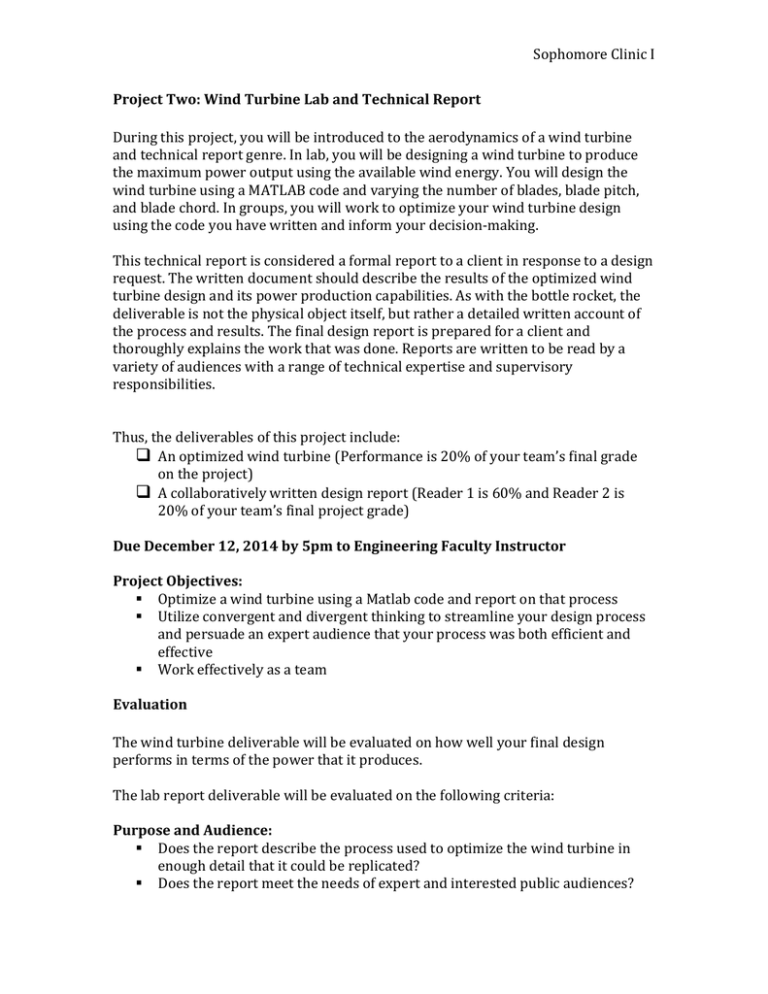Sophomore Clinic I Project Two: Wind Turbine Lab and Technical
advertisement

Sophomore Clinic I Project Two: Wind Turbine Lab and Technical Report During this project, you will be introduced to the aerodynamics of a wind turbine and technical report genre. In lab, you will be designing a wind turbine to produce the maximum power output using the available wind energy. You will design the wind turbine using a MATLAB code and varying the number of blades, blade pitch, and blade chord. In groups, you will work to optimize your wind turbine design using the code you have written and inform your decision-making. This technical report is considered a formal report to a client in response to a design request. The written document should describe the results of the optimized wind turbine design and its power production capabilities. As with the bottle rocket, the deliverable is not the physical object itself, but rather a detailed written account of the process and results. The final design report is prepared for a client and thoroughly explains the work that was done. Reports are written to be read by a variety of audiences with a range of technical expertise and supervisory responsibilities. Thus, the deliverables of this project include: An optimized wind turbine (Performance is 20% of your team’s final grade on the project) A collaboratively written design report (Reader 1 is 60% and Reader 2 is 20% of your team’s final project grade) Due December 12, 2014 by 5pm to Engineering Faculty Instructor Project Objectives: Optimize a wind turbine using a Matlab code and report on that process Utilize convergent and divergent thinking to streamline your design process and persuade an expert audience that your process was both efficient and effective Work effectively as a team Evaluation The wind turbine deliverable will be evaluated on how well your final design performs in terms of the power that it produces. The lab report deliverable will be evaluated on the following criteria: Purpose and Audience: Does the report describe the process used to optimize the wind turbine in enough detail that it could be replicated? Does the report meet the needs of expert and interested public audiences? Sophomore Clinic I Does it persuasively demonstrate that the process used to optimize the wind turbine was both efficient and effective? Is the report convincingly presented as one, unified document despite being collaboratively written? Content: Does the report introduce the design problem including constraints, criteria, context, and parameters? Does it include a description of the final design with enough detail so that it could be replicated? Does the report describe the parametric design process in enough detail so that a reader can judge is efficiency and efficacy? Does it comment on where convergent and divergent thinking were applied? Does it explain why specific choices were made in relation to your data? Does it conclude by summarizing your parametric design process and speculating on changes that you could make in the future to further optimize the wind turbine? Does the report include appropriate figures and tables (at least one figure showing the final design, several figures showing the data, and one table—as an appendix—showing all raw data)? Are the figures and tables presented in the most helpful way? Format, Organization, and Style Does the report use informative headings? (Title Page, Executive Summary, Table of Contents, Problem Definition, Design Description, Evaluation, Conclusions, References, Appendices) Is the writing clear, concise, and precise? (e.g. “the power output increased from 1.5 watts to 2 watts” rather than “the power output increased a lot”) Do all aspects of the report format and style follow the Sophomore Clinic Style Guide? Additionally, because the wind turbine and report are team deliverables, you will be evaluated on your team’s collaborative efforts. When turning in the report, please include a cover letter that addresses the following: Each team member’s contributions during lab Each team member’s contributions during writing sections Each team member’s contributions to the final report (including sections written, figures created, editing, etc.)






